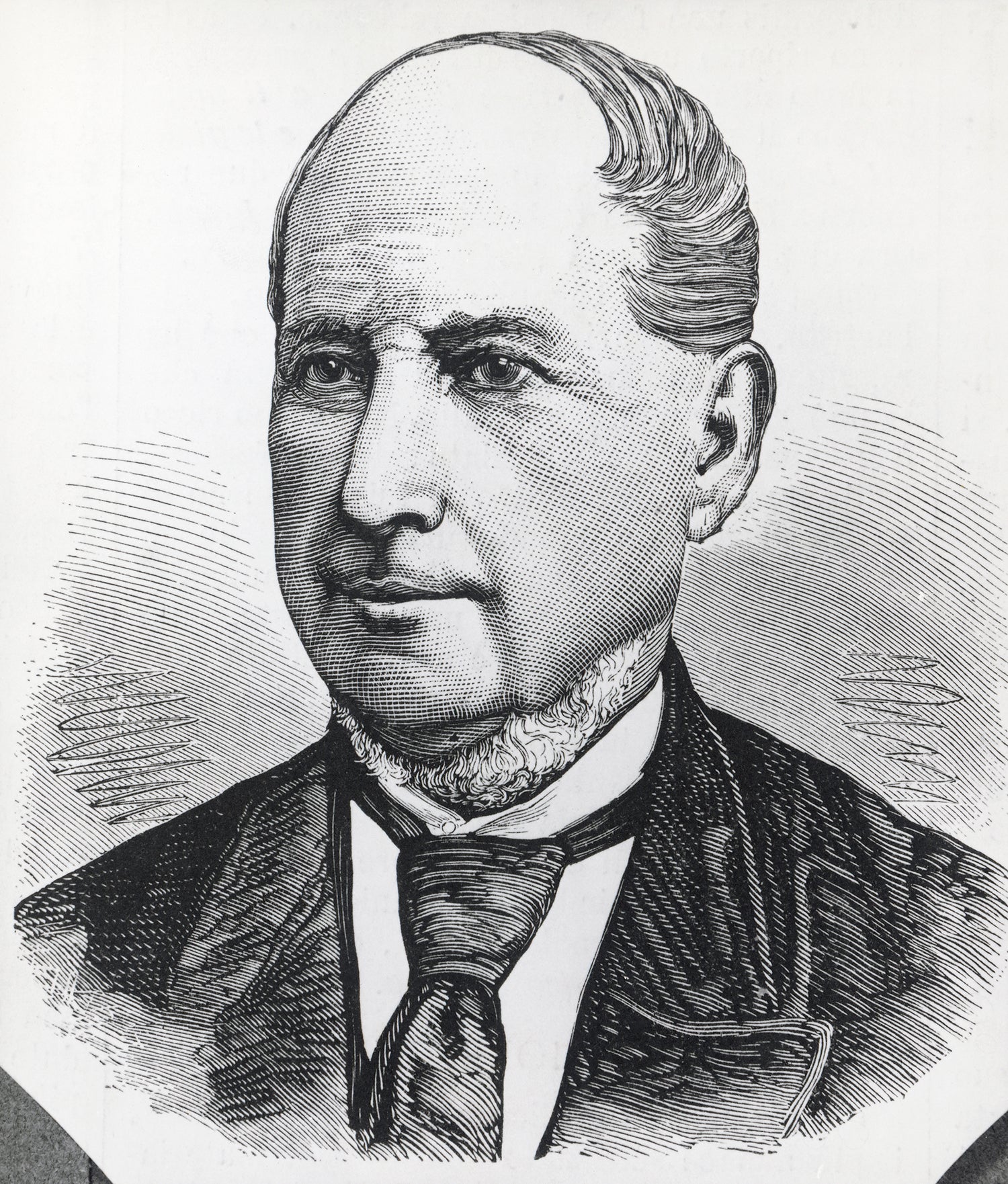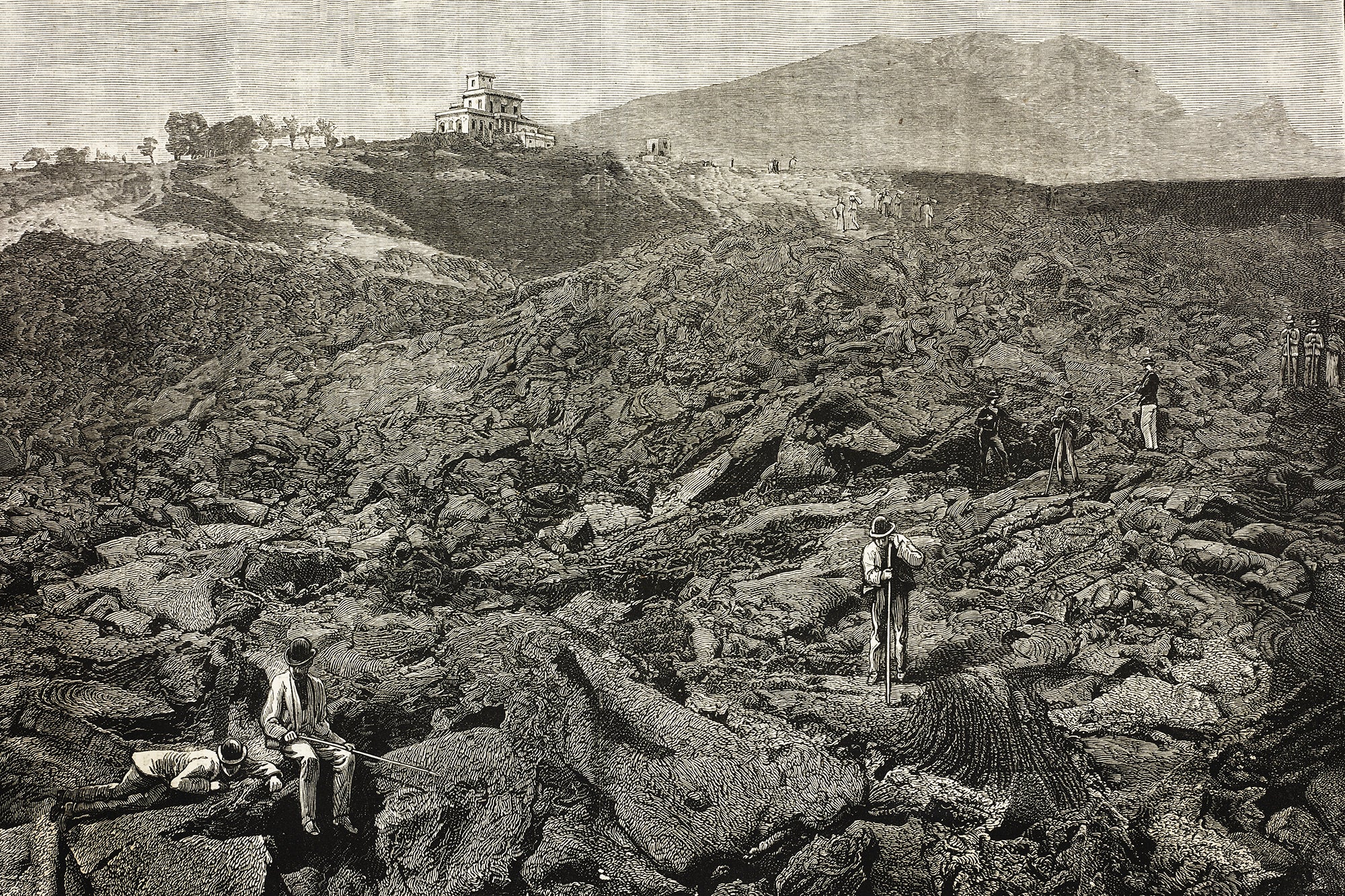On the third day of Mount Vesuvius’s eruption, physicist Luigi Palmieri found himself isolated between torrents of red-hot lava flowing past his stone-walled workplace, the Vesuvius Observatory, on one of the main slopes of the volcano in Italy. Vesuvius bellowed, the ground wavered, and lightning boomed in the immense pine-tree-shaped ash clouds above his head. Searing molten stones rained down on him from the sky. The thermometer on the terrace reached more than 150 degrees Fahrenheit (66 degrees Celsius). Palmieri locked himself inside, but the heat cracked the windows, and a scorching smell filled the baking indoor air.
The year was 1872, and this was one of Vesuvius’s most devastating recent eruptions. Palmieri had chosen to remain in the building so he could study the cataclysm. He certainly knew he risked dying: several scientists had lost their life to the volcano before, and one of them had died just two days prior. Much farther downhill, panicked civilians fled to Naples, Italy, leaving belongings behind before the lava swallowed their homes. Naples’s residents then fled to Rome as more ash fell. People presumed Palmieri had perished. But he continued to check his instruments and write notes in the roasting building while waiting for his time to venture outside. Palmieri wasn’t just being determined. He was ecstatic. “I really desired to see the pine above my head,” he later wrote, seemingly disdainful of the danger. The eruption was a “sensational show,” he added. “Mount Vesuvius was really kind when he sent it to me over the observatory.”
Today, for the time being, Vesuvius—famous for burying Pompei in A.D. 79—is considered quiescent: it is not active, but earthquakes related to its substructure are still occurring. The most recent earthquakes happened on August 8. Many tourists ascend to the summit every day; tickets to the Vesuvius National Park have regularly sold out this summer. Volcanology is now a technologically advanced discipline pursued by thousands of highly trained professionals. But in Palmieri’s day, when study was nascent, measuring eruptions meant remaining on the front line and facing whatever the volcano sent your way. Palmieri, at times reckless, was driven to answer vexing questions that still evade experts: Why do eruptions suddenly happen when they do? Why can’t we predict them? Palmieri’s relentless measurements, often made with instruments he invented, were pioneering.
Palmieri would make an unusual scientist today. Born north of the city of Naples in 1807, he studied physics and mathematics but also philosophy. His first role at the University of Naples was to lecture on logic and metaphysics. His contemporaries described him as vigorous, and yet he had modest, simple manners. Some local people found his work heretical: they thought eruptions were mysterious whims of nature, and Palmieri’s pursuit was challenging their beliefs.

His life and name are inextricably linked to the Vesuvius Observatory, the world’s first volcanological observatory, which he directed for 41 years. It was a pastel-colored three-story building on a hill 2,000 feet above sea level and 1.25 miles from Vesuvius’s crater, which loomed above. Palmieri’s predecessor, Macedonio Melloni, had conceived of it as a meteorological observatory in 1841, but Melloni, a liberal, was ousted by authorities for his perceived sympathy for the Revolutions of 1848. The observatory had fallen into disrepair when Palmieri set his eyes on it. Few instruments remained inside. Bats and owls nested in it, while goats roamed nearby.
Authorities were planning to sell the building to convert it into a hotel when Palmieri began ascending to it for his research in 1852. He only accepted the appointment as the new director in 1855, after Melloni, destitute, died of cholera near the city of Naples.
Palmieri devoted much of his life to subjects that would raise eyebrows today. He researched the link between electricity in the air and the ground. Like many at the time, he believed that it held the solutions to earthquakes’ many mysteries. “The dominant idea was that an excess of electricity in the air discharged lightning and an excess of electricity in the ground discharged earthquakes,” says Giovanni Ricciardi, a retired seismology researcher, who studied a remote-sensing technique called synthetic aperture radar interferometry and bradyseism (vertical ground movements) at the Vesuvius Observatory for four decades until 2019. “Some theorized the building of earthquake rods—like [Benjamin] Franklin’s lightning rod—could intercept a lightning strike and hoped that burying a 15-meter [49-foot] metal rod into the ground could stop earthquakes,” says Ricciardi, who wrote a 900-page history of Vesuvius. (Earthquakes, eruptions and meteorology were all seen as interconnected back then.)
Palmieri’s approach was pioneering at a time when volcanology still straddled science and faith. “He was a measurer,” says Francesca Bianco, who was the observatory’s director until July 2022, when she was promoted to head the volcanoes department at Italy’s National Institute of Geophysics and Volcanology. “He had grasped the fundamental importance of measurements at a time when volcanology was dominated by rather qualitative methods.”
In his first years at the former meteorological observatory, Palmieri equipped it with instruments to study volcanoes—a foundational moment in modern volcanology, according to Mauro Di Vito, the observatory’s current director. He describes the building as a place where “you can feel that many lives have been lived.”
When Palmieri couldn’t find a suitable instrument, he designed a new one. His most significant invention occurred a year after his start at the observatory. Vesuvius erupted frequently at the time, and Palmieri sensed several light earthquakes preceding an eruption. He crafted an instrument that could detect all tremors, even the ones humans couldn’t perceive, and record their direction, intensity and duration on a piece of paper. It could also communicate with other instruments using telegraphic signals. It became the electromagnetic seismograph, the first instrument that measured earthquakes in a way that wasn’t solely mechanical.
Because there was no telegraph line connecting Vesuvius with civilization, let alone remote-sensing technology, studying the volcano involved plenty of fieldwork, sometimes exposing Palmieri to high risks. His first of several brushes with death came in 1859 as he ventured out during an eruption. He walked with the observatory’s caretaker beside a “beautiful river of fire,” he wrote, until they reached its source. Suddenly the lava was propelled into the sky from a minor crater. It solidified in midair and morphed into boulders falling where the two men were, as the volcano roared and smoke billowed from the crater. Observers stationed much farther from the accident fled and left Palmieri and the caretaker for dead. Somehow, they survived unharmed.
After each eruption, Palmieri wrote detailed descriptions of the events and left behind a huge trove of knowledge about everything he witnessed in the observatory’s annals. He lived through eruptions in 1855, 1859, 1861, 1868 and 1871–1872. Palmieri filled pages with measurements, not the drawings from memory and anecdotal observations that were common at the time.
The 1861 eruption he weathered evidently saved the observatory from becoming a hotel. Italy had been unified, and the king, far from Vesuvius in the region of Piedmont, had doubts about the need for the observatory. But the eruption destroyed a town near the volcano, which made it the first natural disaster in the history of unified Italy, and the country’s rulers became convinced that the observatory was useful. The eruption also led Palmieri to find that the sea can withdraw from shore not because of the tide but because the seafloor is moving up and down prior to an eruption.

Ricciardi says Palmieri sowed the seeds of modern monitoring networks because, after he had built two electromagnetic seismographs, he kept one at the observatory and one at the University of Naples. He then used a third, portable one to triangulate and determine a quake’s epicenter and direction. He began to equip train stations and police stations with instruments and telegraphs and showed that for good seismic surveillance, “you need a network of sensors,” Ricciardi says.
Soon the electromagnetic seismograph made Palmieri famous among global elites. The Japanese government asked him for various models. The masses were fascinated with him, too. Residents along Vesuvius’s foothills marveled at Palmieri’s ability to predict eruptions several hours or even days in advance. They thought of him as a magical spirit and treated him like an oracle—newfound faith, this time in a human being.
The exception was, of course, 1872. Palmieri had warned curious people against getting near the volcano—but then he left to pick up an instrument in Naples. A group of students went to inspect a small crater when it collapsed, spewing out lava and firing projectiles into the air. Most of them died. Palmieri returned to the observatory, where he spent the next few days monitoring volcanic activity, and he was so distraught that he allegedly never left the observatory during an eruption again.
After 1872 Palmieri entered a slow decline. Biographers wrote that he hardened and grew isolated in the scientific world. He received plenty of medals and honorary titles for his bravery—and was even appointed a senator of the Kingdom of Italy for his deeds—but he seemed to give them little importance. He turned down the opportunity to hold a series of conferences about the 1872 eruption in the U.S. He claimed to have been the first person to find helium on Earth, in 1868, using spectroscopy on Vesuvius’s fumaroles; helium had only been detected on the sun at that time. But he never studied the subject further and only returned to it to claim credit after Scottish chemist William Ramsay claimed to have discovered the element in 1895.
As competing theories of earthquakes and eruptions emerged, science began leaving Palmieri behind—perhaps a reminder that science is greater than any individual’s contribution to it, no matter how heroic. Palmieri was getting old, one of his contemporaries, V. Sabatini, wrote. Volcanology was speaking a different language. Others noted that Palmieri treated Vesuvius as his belonging and the observatory as his laboratory, even if it was again falling into disrepair.
Palmieri died of “bronchial catarrh” in Naples in 1896, at age 89, shortly after holding a last lecture on the moon’s influence on eruptions—a subject that is still studied today. He left behind 137 memos sent to the Royal Society of London and dozens of books and articles. Several Italian streets, piazzas and lecture halls are named after him, as is a moon crater near the Mare Humorum.
Much of the scientific world that Palmieri helped to create has disappeared. Modern sensor systems and mathematical models far outpace the instruments he invented. The small building perched on Vesuvius now houses a museum. Vesuvius’s importance, too, seems to have waned: the volcano has been quiescent since 1944. Italy’s attention has turned to the nearby Phlegraean Fields, a supervolcano that has shown at least feeble activity.
But Palmieri’s legacy still lives. The Vesuvius Observatory has moved to a five-story glass building outside Naples, and it hosts a team of 110 people who monitor and research volcanoes across Italy. “We study everything there is to study,” says Bianco, its former director. The technology might bear little resemblance to Palmieri’s electromagnetic seismograph, and his heroics are no longer needed in a world where scientists can monitor volcanoes safely from afar. But Bianco assures the approach isn’t different. The observatory itself is an instrument for making observations, she says. “Palmieri introduced that,” she adds.
